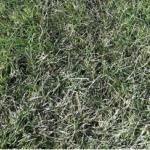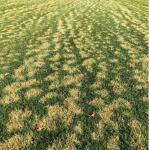John Inguagiato, Ph.D. and Vickie Wallace, UConn, Michelle DaCosta, Ph.D. UMass
Turf managers and homeowners have been puzzled by the sudden appearance of unusual tan, blighted patches that showed up last week between Tuesday and Friday (Nov. 3 - 6). Reports have been widespread throughout Connecticut, Massachusetts, and Rhode
Island.
The symptoms appear as round to irregular-shaped patches of light-tan blighted turf (Figure 1 & 5). Patches are often uniformly distributed across affected turf areas. Density of patches may vary from one every 2 feet to as little as a few inches, with some patches coalescing into larger, irregular shapes (Figure 5). Early onset of symptoms appeared silver-gray to dark purple before turning tan (Figure 2). Symptoms appear to be limited to the upper portion of the turf canopy (Figure 3). Foliage lower in the canopy, stems and crowns do not appear to be injured in most cases.
All cool-season turfgrasses have been reported to be affected. Injury seems to be most severe on exposed, well-fertilized, irrigated lawns and fields. Symptoms on turf maintained at lower mowing heights (e.g., putting greens, fairways, some athletic fields), and newly established areas appears to be less severe.
Chilling injury is rare in New England on cool-season turfgrasses. Many experienced New England turf managers have commented in the past few days that they have never seen anything like this. Symptoms similar to these are more common in the south, on warm-season bermudagrass when exposed to sudden cold weather. However, chilling injury has also been reported in the desert southwest on overseeded perennial ryegrass (Moon et al, 1990).
The recent injury to turfgrasses throughout the region is likely due to a unique combination of environmental conditions impacting the physiological activity of turfgrasses. Cold tolerance of cool-season turfgrasses generally develops during November and December over an acclimation period of slowly decreasing temperatures. This acclimation period prepares turf to tolerate cold winter temperatures. However, turf has been actively growing, green, and photosynthesizing in many areas throughout the region this fall, indicating it has not yet acclimated to cold temperatures.
A Perfect Storm
Throughout much of October daily low temperatures were rarely below 40°F. However, a sustained period of cold to freezing daily low temperatures occurred from Oct. 30 to Nov. 3. (Figure 4). These cold temperatures also coincided with a very dry air mass (dew points approximately 15 to 20°F), and moderate sustained winds with gusts over 30 mph on Monday and Tuesday (Nov. 2 & 3). Moreover, Nov. 2 & 3 were particularly sunny days with high light intensity (solar radiation ~675 to 750 W/m2).
- Sudden onset of cold temperatures
- Dry air and wind (excessive transpiration)
- High light intensity
Similar chilling conditions have been demonstrated to impair the photosynthetic machinery of perennial ryegrass (Moon et al, 1990). When normal photosynthetic processes are interrupted under high light, damaging free radicals can be produced that can destroy important membranes within cells. Ultimately, the integrity of the cells is affected, foliage becomes desiccated, and blight symptoms occur.
Unique Patterns
The unique patterns associated with the chilling injury are more difficult to explain. It is not entirely clear why areas of the same turf are differentially affected. It is likely due in part, to how turbulent air moves across the surface, affecting where cold pockets of air settle to injure turf.
Recovery Outlook
Fortunately, in most cases the symptoms associated with this chilling injury appear to be superficial. Only the upper canopy has generally been affected. Crowns remain healthy, and therefore blighted foliage will grow out. It is possible that with continued warm weather, actively growing turf may fully recover this fall. However, in many cases it is more likely that symptoms will persist through the winter until spring when growth resumes, and blighted tissue is mowed off.
Fertilizing to encourage growth and recovery of the symptoms this fall is not recommended. Since a late fall fertilization can promote succulent turf growth, delaying acclimation and increasing potential for snow mold and other forms of winter injury.
References:
Moon, J.W., Jr. et al, 1990. Limitations of photosynthesis in Lolium perenne after chilling. J. Amer. Soc. Hort. Sci. 115:478-481.




